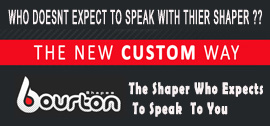I have been spending a lot of time designing high performance hybrids to make in EPS the last few years and just recently the thought occurred to me why not make a real high performance design out of EPS? To date the thought pattern with EPS was to buy some more float in small fishy designs so heavier or older guys can get the sensation of a small board without struggling too much in the paddle department. And this is where I believe the use of EPS is certainly a big advantage and the downsides are outweighed.
The corky bounce of EPS in choppy conditions is what most people describe as the downside. Up to now I have resisted designing high performance thrusters in EPS since the sort of guys that rip on these types of designs are happy with their PU’s and are so keen they will surf in all sorts of shitty conditions where the EPS may let them down.
Just recently we were all blown away with KS and his wave pool ripping on an EPS in perfect glass faced barrels, which sort of made me think it may well be time to introduce this medium into some of my high end stuff. It may be some time before we get to surf in a wave pool but small to medium glassy conditions are not all that rare and these are the conditions where the HP-EPS will be the magic carpet .

THE DESIGN
I have 2 high performance designs that have performed really well the last few years. Firstly the Slick which is a full curvy deep concaved high performance thruster and secondly the Bottom feeder which is also deeply concaved but has a lower nose entry and more intense flip in the tail which is more suitable for waves with a little less power. To create the HP-EPS I used both these designs and blended them together. Lowered the rails a tad to help penetration since there is more float in EPS. The thickness of the design is also minimal due to the extra buoyancy keeping the surfer in the water rather than too much on top.
GLASSING
I have always liked the spring of stringerless EPS particularly glassed with the double diagonal glass process, but for more powerful surfers the flex delay may annoy them. So to make the spring more tensile I have run 2 carbon strips on the deck and one wider one down the centre on the bottom, which splits off to the rails just behind the front fins. The reason for this is too give the actual tail directly below the back foot a little more relief flex that co-ordinates with the slight flip out the tail. The deck has a carbonated 6 oz patch on the tail to prevent the back foot denting which occurs in most well used high performance boards.
All this glass does add weight to the board, but remember there is not much weight in the EPS core so by and large we end up with a board much stronger and still slightly lighter than a PU. The trap in trying to make an EPS ridiculously light is they break too easy, but more importantly they jump around in chop too much which renders them useless in half the surf conditions this type of surfer is prepared to surf in. The buoyancy of my fused pellet EPS is less than the EPS block foam so having that on their side as well as a tad more weight they will tolerate chop a lot better.
DIMENSIONS
5.10 X 18 5/8 X 2 ¼ = 25.88 LTS
5.11 X 18 ¾ X 2 5/16 = 26.98 LTS
6.0 X 18 7/8 X 2 5/16 = 27.57 LTS
6.1 X 19 X 2 3/8 = 28.67 LTS
6.2 X 19 1/8 X 2 7/16 = 29.89 LTS



